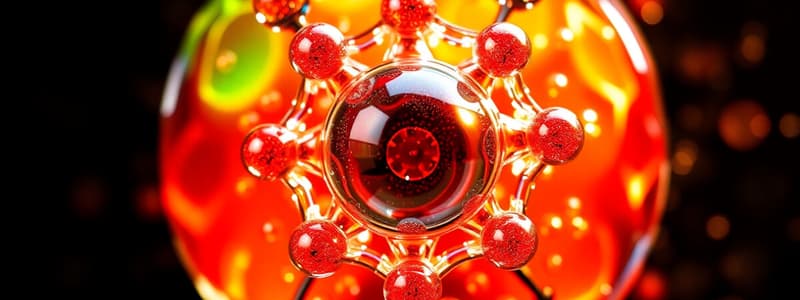Podcast
Questions and Answers
What is the atomic number of an element indicative of?
What is the atomic number of an element indicative of?
- The total mass of the atom
- The total number of protons in the nucleus (correct)
- The total number of electrons in an unstable atom
- The total number of neutrons in the nucleus
Which of the following statements about ions is true?
Which of the following statements about ions is true?
- Ions have different numbers of protons and electrons. (correct)
- Ions cannot change charge.
- Ions contain the same number of neutrons as the neutral atom.
- Ions are more stable than neutral atoms.
How do you determine the number of neutrons in an atom?
How do you determine the number of neutrons in an atom?
- By doubling the atomic number
- By subtracting the atomic number from the atomic mass (correct)
- By adding the atomic mass and atomic number
- By counting the number of protons
What type of bond is formed when atoms share electrons?
What type of bond is formed when atoms share electrons?
What happens when the number of protons in an atom changes?
What happens when the number of protons in an atom changes?
Which of the following correctly identifies a characteristic of a molecule?
Which of the following correctly identifies a characteristic of a molecule?
What is the effect of a decrease of one whole number on the pH scale?
What is the effect of a decrease of one whole number on the pH scale?
Which of the following compounds contains ionic bonds?
Which of the following compounds contains ionic bonds?
What are isotopes primarily characterized by?
What are isotopes primarily characterized by?
What is the significance of the periodic table of elements?
What is the significance of the periodic table of elements?
What defines a compound in chemistry?
What defines a compound in chemistry?
Which of the following statements is true about pH?
Which of the following statements is true about pH?
What happens to the total atomic mass of an atom if its number of neutrons increases?
What happens to the total atomic mass of an atom if its number of neutrons increases?
In which type of bond does one atom transfer electrons to another?
In which type of bond does one atom transfer electrons to another?
If an atom has a charge, how is it classified?
If an atom has a charge, how is it classified?
What characterizes isotopes of an element?
What characterizes isotopes of an element?
How are protons described regarding charge and location?
How are protons described regarding charge and location?
How does the pH scale indicate basicity?
How does the pH scale indicate basicity?
Which of the following best describes the atomic number of an element?
Which of the following best describes the atomic number of an element?
What is a fundamental unit of a compound called?
What is a fundamental unit of a compound called?
Flashcards
Element
Element
The simplest form of matter, which cannot be broken down further.
Atom
Atom
The smallest unit of an element.
Proton
Proton
Positively charged particle found in the nucleus.
Neutron
Neutron
Signup and view all the flashcards
Electron
Electron
Signup and view all the flashcards
Atomic Number
Atomic Number
Signup and view all the flashcards
Atomic Mass
Atomic Mass
Signup and view all the flashcards
Ion
Ion
Signup and view all the flashcards
Isotope
Isotope
Signup and view all the flashcards
pH Scale
pH Scale
Signup and view all the flashcards
Element
Element
Signup and view all the flashcards
Atom
Atom
Signup and view all the flashcards
Atomic Number
Atomic Number
Signup and view all the flashcards
Atomic Mass
Atomic Mass
Signup and view all the flashcards
Ion
Ion
Signup and view all the flashcards
Isotope
Isotope
Signup and view all the flashcards
Compound
Compound
Signup and view all the flashcards
Ionic Bond
Ionic Bond
Signup and view all the flashcards
Covalent Bond
Covalent Bond
Signup and view all the flashcards
pH Scale
pH Scale
Signup and view all the flashcards
Study Notes
Basic Chemistry
- Elements are the simplest form of matter, indivisible
- 120 known elements, each with a unique symbol (e.g., Au for gold)
- Elements are composed of atoms
- Atoms consist of protons, neutrons, and electrons
- Protons are positively charged, located in the nucleus
- Neutrons have no charge, located in the nucleus
- Electrons are negatively charged, orbit the nucleus
- Atomic number is the number of protons, also the number of electrons in a neutral atom
- Atomic mass is the sum of protons and neutrons
- To find number of neutrons, subtract atomic number from atomic mass
- Changing the number of electrons creates an ion (charged atom)
- Changing the number of protons creates a different element
- Changing the number of neutrons creates an isotope (unstable and radioactive)
- Compounds are formed when two or more elements combine
- Compounds can be held together by ionic or covalent bonds
- Ionic bonds involve one atom donating an electron to another
- Covalent bonds involve atoms sharing electrons
- A molecule is the smallest functional unit of a compound
- pH scale measures the concentration of hydrogen ions in a solution
- Logarithmic scale (each whole number change represents a tenfold difference)
- pH 7 is neutral
- pH below 7 is acidic
- pH above 7 is basic (alkaline)
Studying That Suits You
Use AI to generate personalized quizzes and flashcards to suit your learning preferences.




